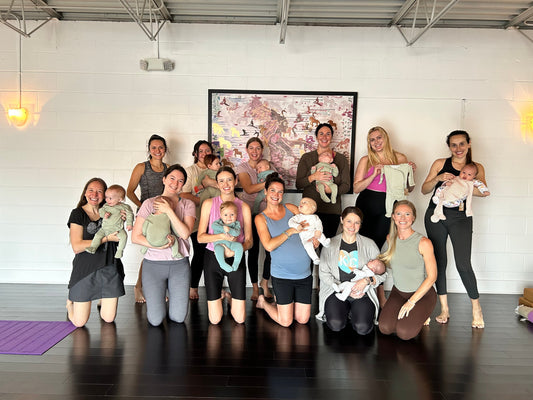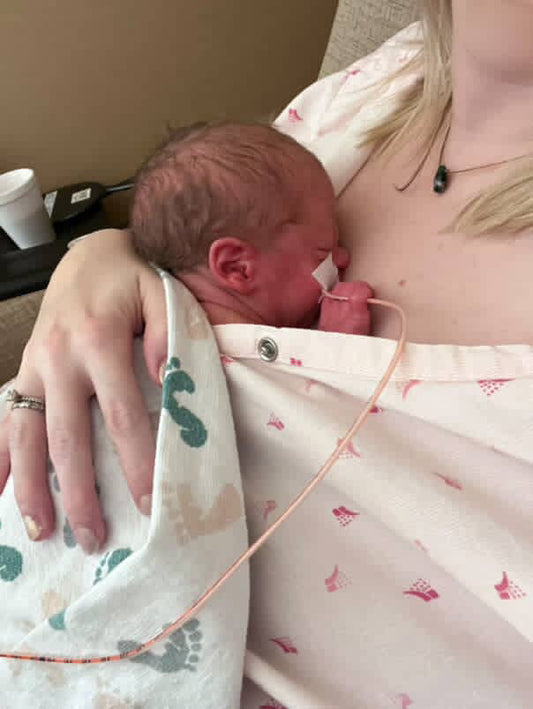Share
Calm in the Chaos: Olivia’s Story of Skin-to-Skin, Strength, and Bringing Baby Diana Home
Emily ShepardWhen Olivia Kim found out she was pregnant, it felt surprisingly easy. “I remember telling my doctor that I felt like this pregnancy was really easy.”. She didn’t experience major discomfort or complications—until one night, at just 31 weeks and 2 days, everything quickly changed.
She began cramping—nothing intense, just light discomfort, and went to work and continued on with her day as usual. She wondered if it could be Braxton Hicks and even Googled how to get rid of cramps. “I was just having light cramping, like a period, and figured it must be Braxton Hicks.” She timed her contractions before bed. “They weren’t five minutes apart—just 8 minutes, 12 minutes, 6 minutes.” Still unsure, she went to sleep.
She woke up again in the middle of the night when the cramps became more severe. At 1 a.m., she called the on-call doctor—but no one called her back. Then, around 3 a.m., after seeing blood in the toilet, she and her husband headed to Labor and Delivery. On the way out the door, she experienced what she believed was the “bloody show.”
“As soon as I was admitted to triage, the pain went from 0 to 100 so quickly.” Olivia had no idea her labor had already progressed so far; she was already 9 centimeters dilated. Her daughter, Diana was born 38 minutes after Olivia arrived at the hospital.
“I always thought I was going to be one of those women who was super calm and collected during labor—that was not the case. There was no time.” Olivia recalled screaming, moaning, and having her eyes closed as the team around her rushed to respond. “It got really scary when the doctor told me that my daughter’s heart rate was dropping.”
She was moved from one bed to another, on her way to the operating room for an emergency C-section. “All the nurses were running down the hallway… they put me on the table in the OR.” At the last possible moment, her baby began to crown. “OK, Olivia, she is crowning,” someone said. Her doctor had to get her attention repeatedly: “Olivia, you need to bear down!” Olivia was given a small episiotomy and delivered her baby vaginally—just in time. “The doctor told my husband that we almost delivered our baby at home.”
Diana in the NICU.
Diana, was born at 31 weeks, weighing 4 lbs, 2 oz.
“I thought she was going to be way smaller,” Olivia said. Before she fully understood the road ahead, her first thought was, “Oh, she’s fine.”
The NICU: Building a Routine, Finding Calm, and the Power of Skin-to-Skin
Diana was immediately taken to the NICU and intubated. “My husband and I were in shock after what happened,” Olivia said. But not long after delivery, a neonatal doctor came to speak with them. “He said, ‘Your daughter is in really good hands—she looks healthy for a 31-week baby.’” The care team walked them through what to expect in the weeks ahead, helping to calm their fears.
Olivia admires her beautiful baby, Diana, in the NICU.
While the NICU isn’t often associated with peace, Olivia remembers a surprising sense of calm. “Emotionally, I felt very calm because all the nurses we had were really great, and it seemed like they even built a relationship with our baby.”
Still, those first two weeks were the hardest. “She had to be intubated for a day, she had to be on the blue light for several days, and she was having a difficult time breathing.” At first, they weren’t allowed to hold her. “We were allowed to touch her hand on day one—but she had a really sensitive IV, so for four days we couldn’t hold her until after they moved the IV.”
Finally, on day five, Olivia was able to hold Diana skin-to-skin for the first time.
Olivia connects with Diana in the NICU.
“We primarily did skin-to-skin whenever we held her. The stress of moving her from isolette to person was a lot. We just held her for one hour a day. Eventually, we were able to hold her as much as we wanted.” It quickly became the heart of their daily routine.
“My husband and I both noticed that when we practiced skin-to-skin, we both felt so tired—we attributed it to the oxytocin. We were so relaxed,” she said. Diana responded to it too. “Whenever we took her out of her crib, she was definitely calmer when we practiced skin-to-skin. Skin-to-skin kept her content.”
According to a major study published in BMJ Global Health, practicing skin-to-skin care—also known as kangaroo care—for at least eight hours a day can reduce the risk of death for preterm or low-birth-weight babies by up to 32% in the first month of life.
For Olivia and Diana, those quiet, skin-to-skin moments were more than soothing—they were essential.
Olivia holds Diana for the first time, skin-to-skin.
Soon, the NICU days took on a steady rhythm. “Wake up early, eat breakfast, stay all day at the NICU.” Olivia described the experience like a full-time job—one she and her husband were fully committed to. “After about a week and a half, my husband went back to work. He came straight to the NICU after work and we spent time together as a family.”
At 34 or 35 weeks, Diana started breastfeeding for the first time. “Breastfeeding started the day after Mother’s Day.” Though she still had her NG tube, she began practicing both bottle and breast feeds. “She latched really well. Bottles were more frustrating—then she was so tired after trying to bottle feed.” Olivia reminded herself: “She’s still early.”
More Than a Birth Story: A Journey to Connection and Care
Before Olivia held Diana for the first time in the NICU, her story began with a different kind of struggle—one that many women face silently. “Long story short, I was diagnosed last year with hypothalamic amenorrhea (HA), which is where your brain tells your body to shut down its menstrual cycle amongst other things,” she said.
For Olivia, the diagnosis brought years of questions into focus. “I struggled with disordered eating in high school around the time of puberty and did not get a period until I was 17 without the help of birth control.” Despite recovery, her cycle never fully returned—until she met a doctor who gave her clear guidance: “I needed to gain weight for my fertility, heart health, bone health, etc.”
She took HA recovery seriously. “Since age 17, I had my second-ever period in August 2024 as a 25-year-old, and then in October, I got pregnant!”
Even though the pregnancy came quickly after recovery, Olivia remained realistic. “I don’t think my body was ready to deal with it for 40 weeks,” she said. “Pregnancy is quite the big demand. I had just started to cycle like a female should. I’m so grateful that I got to carry Diana for as long as I did.”
Diana is all smiles in the NICU.
Now, postpartum, Olivia is focusing on nourishment and care for both her baby and herself. “As I wait for my cycle to return, I’m making sure to eat sufficient calories to not only help with breastfeeding, but also to support my own body for future kids.”
Looking back, she hopes her story encourages other women to rethink what true health looks like. “I think it’s really important for future or current moms to prioritize their menstrual health rather than looking a certain way, eating certain foods, or working out hours a day. None of that stuff is worth it if your hormones are low and your body isn’t cycling—for pregnancy or not.”
At Bonsie, we believe caring for your baby begins with caring for yourself—and we’re honored to support families like Olivia’s with tools that nurture connection, from skin-to-skin in the NICU to every calm moment at home.
A Bonsie Baby, a Special Homecoming, and Encouragement for Other NICU Parents
During “Kangaroo Week” in the NICU, Olivia participated in a raffle—and won a Bonsie Skin to Skin Babywear™ Onesie. She reached out via email to say thank you and share her experience.
“I am contacting you to say thank you for the Bonsie Babywear! I won it in a raffle during ‘Kangaroo Week’ in the NICU. I’m excited to try it out tomorrow! My daughter was born premature at 31w 2d, and needless to say, her early entrance was the last thing my husband and I saw coming. Thankfully, she is doing very well at CGA 36w 1d—eating a lot, almost off her oxygen, and gaining weight.”
She added, “Skin-to-skin is the highlight of my day, and I think it has truly helped both of us get through this difficult journey.”
Bonsies are designed to make skin-to-skin more accessible—especially in the NICU, where moving or undressing a baby with oxygen support and monitors can be stressful. Designed to open easily on the front, it allows for contact without disturbing medical attachments.
Olivia, her husband, and Diana get ready to go home from the hospital.
Diana was discharged on Father’s Day—a fitting celebration after 53 days in the NICU. At home, skin-to-skin remains part of their daily routine. “I notice that now that we’re home, she naps best when we do skin-to-skin,” Olivia said. “We still practice it all the time.”
Looking back, Olivia has simple but powerful advice for other NICU parents:
“It’s obviously scary to see your baby hooked up to monitors—trust the nurses and medical staff and always ask all your questions. Sometimes doctors only tell you what they think you need to know—ask all your questions because usually it will calm your fears. All babies are different. Your baby can turn a corner really quickly for the better. It’s not a fun time to be in the NICU, but your baby can really surprise you.”
At Bonsie, we know just how important skin-to-skin contact is, and believe in making this vital practice easier for families—whether you're in the NICU or at home. We design babywear that opens simply, accommodates medical devices, and supports the powerful connection between parent and child.
Olivia and Diana practice skin-to-skin contact.
We're so grateful to Olivia for sharing her story, and to every NICU family who shows the world what love, touch, and resilience truly look like.
Explore our NICU-friendly Skin to Skin Babywear™ collection here.
Sources:
Sivanandan, S., & Sankar, M. J. (2023). Kangaroo mother care for preterm or low birth weight infants: A systematic review and meta-analysis. BMJ Global Health, 8(6), e010728. https://doi.org/10.1136/bmjgh-2022-
Share
-
Category:
- All posts



